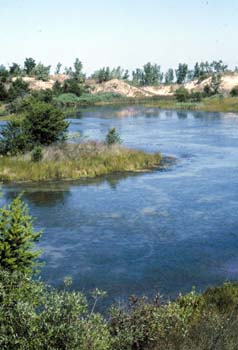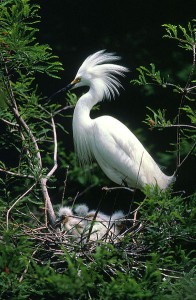An interactive map showcases successful federal restoration projects in the Great Lakes states, including projects from the $475 million Great Lakes Restoration Initiative.
It is produced by the Healing Our Waters-Great Lakes Coalition, an association of more than 120 environmental and conservation groups.
Here’s a quick look at what the coalition views as success stories in Indiana:
The restoration of a submerged stream at the Indiana Dunes State Park created new habitat for fish and curbed the polluted runoff and bacterial pollution on a nearby Lake Michigan beach.

The state park is included within the Indiana Dunes National Lakeshore (pictured above). Photo: National Park Service.
The $2 million project exposed the previously underground Dunes Creek. The creek was forced into a large pipe in the 1930s so that a parking lot could be built over it, according to the coalition. Nearly 1,525 feet of the creek has been uncovered since 2005. Numerous state and national awards have since been given the park, which features a new boardwalk for pedestrians.
Another success is the $1.6 million Trail Creek lamprey barrier in Michigan City. The barrier was built to halt the spread of invasive sea lamprey.
The voracious, eel-like fish has wiped out much of the Great Lakes lake trout population by the late 1940s, according to the coalition. The bi-national Great Lakes Fishery Commission has reduced lampreys by 90 percent in most Great Lakes regions by releasing sterile males and using anti-lamprey chemicals. The barrier complements those efforts by preventing them from accessing spawning habitat.

The Grand Calumet River. Photo: Environmental Protection Agency.
But there is still plenty of work in progress in Indiana, including the cleanup of contaminated sediments at the Grand Calumet River and Roxana Marsh.
Phase I of the project cleaned up 120,000 cubic yards of polychlorinated biphenyl (PCB), polycyclic aromatic hydrocarbon (PAH), heavy metal and pesticide-contaminated sediment from the west branch of the Calumet River in 2011, according to the Environmental Protection Agency.
Phase II removed 235,000 cubic yards of polluted river mud between Columbia Avenue in Hammond and Indianapolis Boulevard in East Chicago and from the nearby Roxana Marsh. It was completed in 2012.
Smaller restoration areas have seen $6 returned for every dollar of investment, which could mean the community around this larger, more complex site could have even more of an economic boost, Cameron Davis, senior adviser on the Great Lakes to EPA, said at one press event.

A snowy egret. Photo: U.S Fish and Wildlife Service.
Snowy egrets have made the restored marsh their home and other native species have returned, Davis said.
Other Indiana work in progress includes the restoration of the larger Indiana Dunes National Lakeshore. This project aims to remedy dune erosion damage caused by navigational harbors and other built infrastructure. Park resources, recreation opportunities, homes and businesses are threatened by the dunes’ erosion, according to the National Park Service. The National Park Service is authorized to remedy the causes of the erosion.
The benefits of these and other restoration projects help Indiana’s economy, according to a report by the Great Lakes Commission, an interstate public conservation agency.
Indiana’s Lake Michigan shoreline supports a $14 billion shipping industry and 100,000 related jobs, according to the commission. The state hosts nearly 2 million annual visitors to the Indiana Dunes National Lakeshore, is home to a $2 billion boating as well as a $400 million sport fishing industry, all environment dependent benefits preserved by restoration projects.
If you look at the basic pricinciple of the lamprey control program, the bulk of the effort attacks the juvenile lampreys, (more effective than chasing adults around the lake) they can poison them because they’re stuck in one spot for years. Now most of the other invasive species are mobile in thier juvenile stage we can’t kill the whole system without killing all fish, so we need a mobile control system, that would be native predators, they will seek out the invasives and they work for food. Ecosystem friendly. They say a lamprey can kill 35 pounds of lake trout, so 2 or 3 fish maybe 4? An alewife can eat thousands of larval perch and walleye etc.. thus killing many more fish than lampreys. I believe we should look at numbers of fish affected not pounds. Numbers are the key to who wins, ( “More eggs biological safety factor” MDNR) more fish more eggs. Any thoughts?
I read where the lampreys in thier native habitat (Pacific northwest) are threatened by non-native Walleye Predators. Walleyes eat lampreys in the Detroit river top lure is a lamprey look a like. I even read where walleyes root lampreys out of the mud. Not much research on walleye/lamprey but it makes sense, lampreys are just a blind worm until they get big, when they hatch perfect food size as they drift toward the lake. I’m not saying stop current lamprey plans, but increased predation on lampreys can only reduce thier numbers further, and that would be a good thing. Every invasive species eaten by a native predator is 100% controlled, if walleyes are a threat to lampreys there, they would be here. We need to ramp up our attack on invasive species, they’re winning.